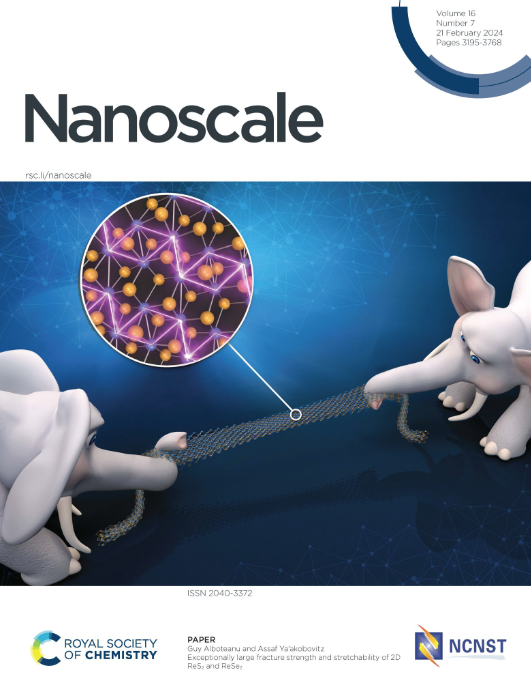Electrochemical analysis of flexible symmetric supercapacitors using WSe2@graphite thin film electrodes under different pH conditions.
IF 5.8
3区 材料科学
Q1 CHEMISTRY, MULTIDISCIPLINARY
引用次数: 0
Abstract
A key focus of this research is to investigate the influence of electrolyte pH on the supercapacitive performance of a flexible symmetric supercapacitor (SS) based on WSe2@graphite composite electrodes. To represent distinct pH environments, three aqueous electrolytes, namely H2SO4 (acidic), NaOH (basic), and Na2SO4 (neutral), were selected. A range of standard characterization methods, including X-ray diffraction (XRD), field emission scanning electron microscopy (FE-SEM), X-ray photoelectron spectroscopy (XPS), atomic force microscopy (AFM), and energy-dispersive X-ray spectroscopy (EDX), were employed to validate the successful fabrication and integrity of the supercapacitive electrode. Electrochemical performance was evaluated through cyclic voltammetry (CV), galvanostatic charge-discharge (GCD) and electrochemical impedance spectroscopy (EIS), elucidating the charge storage behaviour of the device at different pH levels. As a result, the fabricated SS device exhibited an impressive electrochemical potential window of 2 V (0 to +2 V) across all electrolytic systems, demonstrating excellent operational stability and pH adaptability. Among the tested electrolytes, the acidic H2SO4 electrolyte demonstrated the highest performance, achieving a high areal capacitance of 123.73 mF cm-2 and an energy density of 68.73 μWh cm-2 at a current density of 1 mA cm-2. Furthermore, the device demonstrated reliable cycling stability, retaining approximately 78.69% of its initial capacitance after 5000 consecutive GCD cycles. These results highlight the critical role of electrolyte pH in tailoring supercapacitor performance and provide valuable insights into the design of high-performance, flexible symmetric supercapacitors through strategic electrolyte selection.利用WSe2@graphite薄膜电极对柔性对称超级电容器在不同pH条件下的电化学分析。
研究电解液pH值对基于WSe2@graphite复合电极的柔性对称超级电容器(SS)超电容性能的影响。为了代表不同的pH环境,我们选择了三种水溶液,即H2SO4(酸性)、NaOH(碱性)和Na2SO4(中性)。采用x射线衍射(XRD)、场发射扫描电镜(FE-SEM)、x射线光电子能谱(XPS)、原子力显微镜(AFM)和能量色散x射线能谱(EDX)等一系列标准表征方法验证了超级电容电极的成功制造和完整性。通过循环伏安法(CV)、恒流充放电法(GCD)和电化学阻抗谱法(EIS)对器件的电化学性能进行了评价,阐明了器件在不同pH水平下的电荷存储行为。结果表明,制备的SS器件在所有电解系统中都表现出令人印象深刻的2 V(0至+2 V)电化学电位窗口,表现出出色的操作稳定性和pH适应性。在所测试的电解质中,酸性H2SO4电解质表现出最高的性能,在电流密度为1 mA cm-2时,其面电容高达123.73 mF cm-2,能量密度为68.73 μWh cm-2。此外,该器件表现出可靠的循环稳定性,在连续5000次GCD循环后保持约78.69%的初始电容。这些结果突出了电解质pH值在定制超级电容器性能中的关键作用,并通过战略性电解质选择为高性能,柔性对称超级电容器的设计提供了有价值的见解。
本文章由计算机程序翻译,如有差异,请以英文原文为准。
求助全文
约1分钟内获得全文
求助全文
来源期刊

Nanoscale
CHEMISTRY, MULTIDISCIPLINARY-NANOSCIENCE & NANOTECHNOLOGY
CiteScore
12.10
自引率
3.00%
发文量
1628
审稿时长
1.6 months
期刊介绍:
Nanoscale is a high-impact international journal, publishing high-quality research across nanoscience and nanotechnology. Nanoscale publishes a full mix of research articles on experimental and theoretical work, including reviews, communications, and full papers.Highly interdisciplinary, this journal appeals to scientists, researchers and professionals interested in nanoscience and nanotechnology, quantum materials and quantum technology, including the areas of physics, chemistry, biology, medicine, materials, energy/environment, information technology, detection science, healthcare and drug discovery, and electronics.
 求助内容:
求助内容: 应助结果提醒方式:
应助结果提醒方式:


